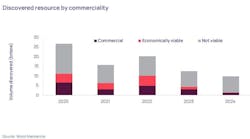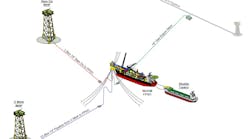Andrew Long
PGS
An increasing catalogue of case studies demonstrates that the dual-sensor Geo Streamer enables more accurate reservoir description, and, reduces the dependence on well log data. This goes beyond the well-known survey efficiency, signal penetration, and resolution improvements.
The much broader frequency bandwidth of the target signal at all depths enables a cascading series of benefits. Attenuation in the earth is better understood, enabling more robust wavelet extraction at the target. In addition to greater high frequency signal resolution, the low frequency signal is stronger. This translates to a reduced dependency upon well log data to constrain the low frequency model of the earth, and improve our ability to characterize rock and fluid properties directly from the GeoStreamer data alone. Furthermore, advanced methods such as full-waveform inversion (FWI) to build accurate velocity models for depth imaging also benefits from stronger frequencies below 5 Hz, and allows better resolution and description of reservoir properties. Finally, recent reservoir monitoring (“4D”) experience also demonstrates the flexibility and power of dual-sensor data processing for achieving very high levels of target signal repeatability.
By the end of February 2010, PGS’ dual-sensor GeoStreamer had been in 3D operation for just over a year, and in 2D operation for two and a half years. More than 10,000 sq km (3,861 sq mi) of 3D had been acquired worldwide, and more than 100,000 line km (38,610 mi) of 2D in a variety of geologies and geographies. In all cases, the data and operational benefits have been clear. But the real benefits for characterizing reservoir properties and structure are just beginning to be seen.
The seismic results delivered by dual-sensor acquisition and processing benefit from improved low- and high-frequency amplitudes, delivered with a low noise floor over the entire bandwidth. This low noise level occurs because the GeoStreamer usually is towed 15 to 25 m (49 to 82 ft); deeper than conventional streamers. While conventional (hydrophone-only) streamers towed deep would be strong in low frequencies, they would be very weak in mid and high frequencies. In contrast, the dual-sensor is strong in both. This difference is because the effects of the receiver ghost can be removed by dual acquisition and processing. The high frequency content is greater than even if a conventional streamer was towed shallow, but does not suffer from the surface-related noise problems.
Operationally, deep towing has advantages. Where sea surface and environmental forces cause operational downtime for conventional streamers towed shallow, deeper tow operations often can continue.
Opening new regions
Undiscovered oil and gas are believed to occur beneath the Arctic and other regions that are accessible only with conventional streamers for short periods each year. Even then, operations are sporadic. A recent example from the North Sea (Osnes et al., 2010) shows that adjacent six streamer operations yielded entirely different weather-related downtime. The conventional streamer experienced 24% downtime, whereas the GeoStreamer experienced 4% downtime through the same two months. This performance advantage becomes relevant in harsh environments such as the Arctic, where seasonal acquisition windows are short. Experience also demonstrates that GeoStreamer operations are less affected by seismic interference.
More bandwidth, more control
Historically, the effects of the receiver ghost on high frequencies could be addressed only by deterministic processing methods such as spectral shaping and corrections for earth attenuation such as “Q compensation.” In all cases, signal-to-noise content is unacceptably damaged near the receiver ghost notches, as noise typically is boosted more than signal (Tabti et al., 2009). In contrast, dual-sensor processing removes the notches in the frequency spectrum without affecting noise, and provides a much larger frequency bandwidth that can be used for subsequent seismic interpretation and reservoir characterization.
In Vigner et al. (2010), the noise floor in the data dictated that conventional streamer processing only could recover useful target frequencies up to 55 Hz, whereas dual-sensor processing could recover useful target frequencies up to 85 Hz. In other words dual-sensor data delivered a 55% resolution improvement. This is likely to directly impact the quality of interpretation. Better control of both low- and high-frequency signal improved the estimation of the quality factor, Q, which describes the rate of attenuation in the earth. Conventional streamer data delivered a Q estimate of 134, whereas dual-sensor data delivered a Q estimate of 178. This difference affects the stability of the wavelet extracted during seismic inversion used for estimating rock and fluid properties.
Exploration focus is moving towards complex reservoirs containing thin stratigraphic layers, often complicated by internal reservoir flow barriers and faulting. Detailed reservoir characterization studies require broader frequency bandwidth, particularly at the low frequency end. As schematically represented on page 54, frequencies below 10 Hz that are necessary for quantitatively accurate inversion must be derived from well log data, if available, as they are absent on conventional streamer data. In contrast, dual-sensor data contains stronger low frequencies, and thus seismic inversion has less dependence upon well data calibration.
Reiser and Ribeiro (2010) demonstrate an Australian example where the amplitudes of target signal at 4 Hz are 6 dB stronger on GeoStreamer data than conventional streamer data in the same location. This resulted in better resolution and delineation of the gas-water contact of a giant gas field, and better resolution of internal reservoir stratigraphic layering (see below). In another example from the Dutch sector of the North Sea, a spectral decomposition example reinforces the significantly better signal content at only 6.25 Hz.
Dutch sector 2D lines for conventional streamer vs. dual-sensor data. A:, conventional seismic; B, dual-sensor seismic. C and D illustrate the spectral decomposition for conventional and dual-sensor streamer data at 6.25 Hz. The warm color indicates high energy, and cold color indicates low energy in the seismic data at this frequency. From Reiser and Ribeiro (2010).
The benefits of GeoStreamer low frequency data also translate to improved reservoir characterization, through better full-waveform inversion (FWI). This is a high-end technology used to derive accurate velocity models for depth imaging, and, ultimately, to constrain density models of the reservoir. As described in Kelly et al. (2010), FWI theoretically can resolve smaller heterogeneities than the ray theory (i.e. conventional tomographic-based solutions to velocity model building), but only if very low frequencies (less than 5 Hz) are available in the seismic data. This may seem to be a paradox, but demonstrates that both low- and high-frequency signal are necessary for high resolution reservoir characterization.
Kelly et al. (2010) achieved a high resolution velocity model inversion from the combination of high signal-to-noise ratio across a broad frequency bandwidth and strong low frequency signal content present within GeoStreamer data from offshore Cyprus. The ability to flatten pre-stack image gathers across a larger range of offsets translates to higher resolution imaging, particularly at depths. As discussed earlier, this will also be complemented by better reservoir characterization of rock and fluid properties.
Monitoring the past, constructing the future
There are opportunities for 4D. A full-scale, time-lapse 3D experiment in the North Sea during 2009 demonstrates non-repeatable seismic noise of 11%, despite quite different survey line geometry and tidal conditions (Day et al., 2010). Unique to dual-sensor streamer processing is the ability to reconstruct the seismic image at any effective receiver depth and the ability to identify and correct for errors in receiver depths along the streamer, if they occur (Söllner et al., 2008). It is possible to precisely match a 4D baseline survey acquired with conventional streamers and a 4D monitor survey acquired with dual-sensor streamers at different towing depths. In this scenario it is necessary to process the streamer data to preserve the effects of the receiver ghost, thus matching the baseline survey. Ideally, both the baseline and monitor surveys will be acquired with GeoStreamers, allowing high survey repeatability to be complemented by higher target resolution.
References
Day, A., Widmaier, M., Høy, T., and Osnes, B., 2010, Time-lapse acquisition with a dual-sensor streamer over a conventional baseline survey. EAGE Annual Meeting, Barcelona, June, B036.
Kelly, S., Ramos-Martinez, J., Tsimelzon, B., and Crawley, S., 2010, Methods for extracting the lowest frequencies from dual-sensor, single-streamer acquisition, in a waveform-based inversion strategy. EAGE Annual Meeting, Barcelona, June, A020.
Osnes, B., Day, A., Widmaier, M., Kolbjørnsen, K., Danielsen, V., Lie, J.-E., Jørstad, A.K., Harrison-Fox, D., Lesnes, M., and El Baramony, O., 2010, First 3-D dual-sensor streamer acquisition in the North Sea: an example from the Luno field. EAGE Annual Meeting, Barcelona, June, B026.
Reiser, C., and Riberiro, C., 2010, Dual-sensor streamer acquisition and its impact on reservoir characterisation studies. EAGE Annual Meeting, Barcelona, June, F025.
Söllner, W., Day, A., and Tabti, H., 2008, Space-frequency domain processing of irregular dual-sensor towed streamer data. SEG Expanded Abstracts, 27, 1078-1082.
Tabti, H., Day, A., Schade, T., Lesnes, M., and Hoy, T., 2009, Conventional versus dual-sensor streamer de-ghosting: a case study from a Haltenbanken survey. First Break, 27, 8, 101-108.
Vigner, A., Deighton, M., and Swift, C., 2010, Q estimation on conventional and dual sensor acquisition systems. EAGE Extended Abstracts, EAGE Annual Meeting, Barcelona, June, G022.






